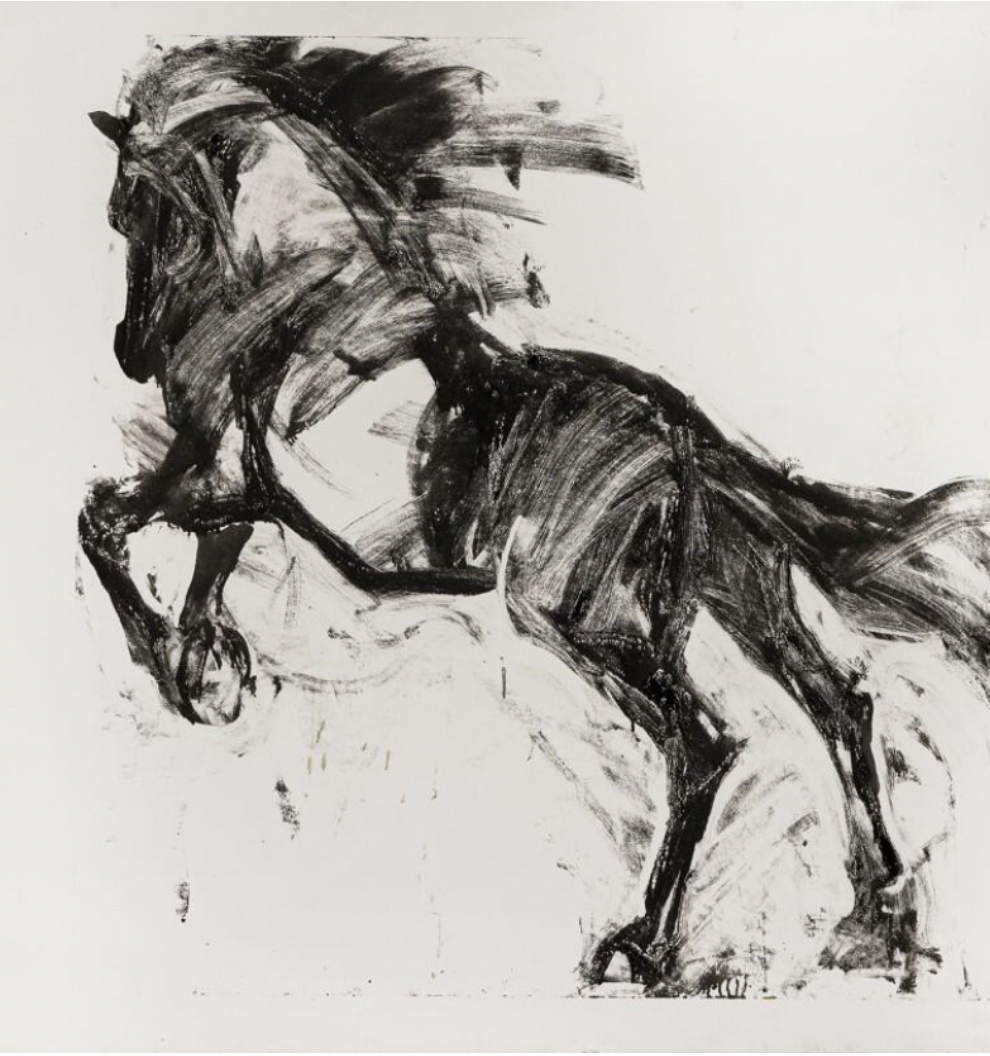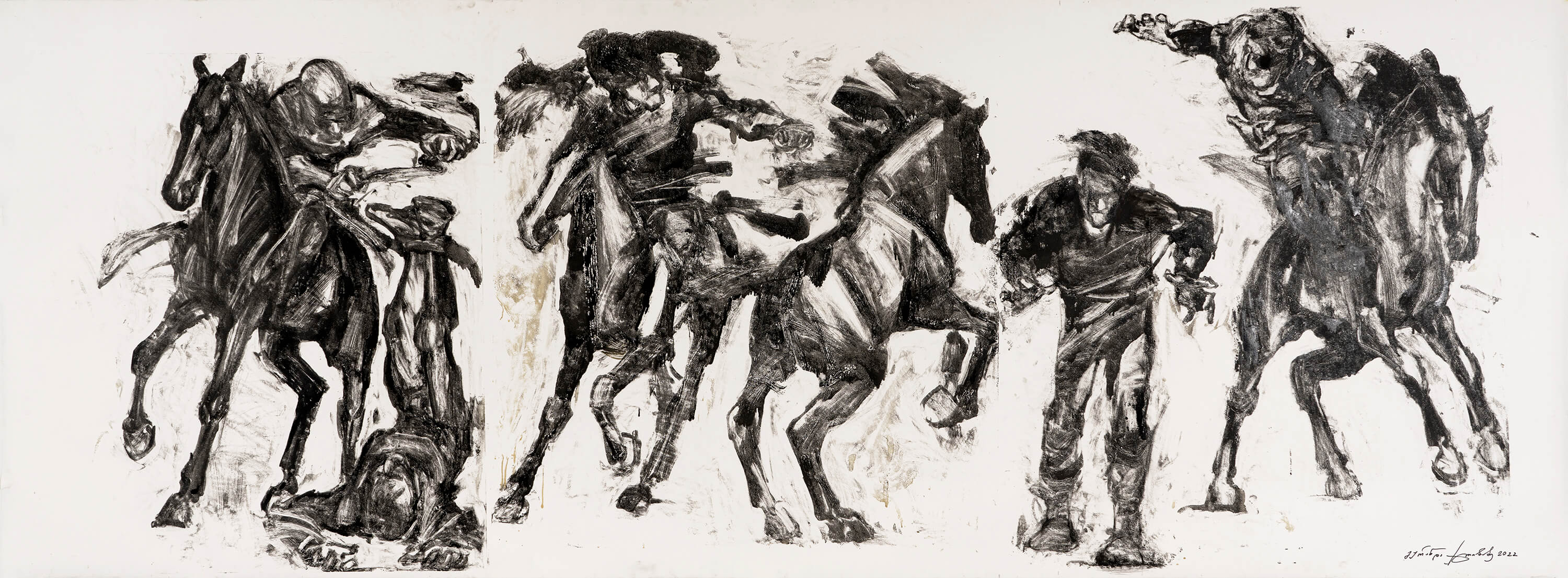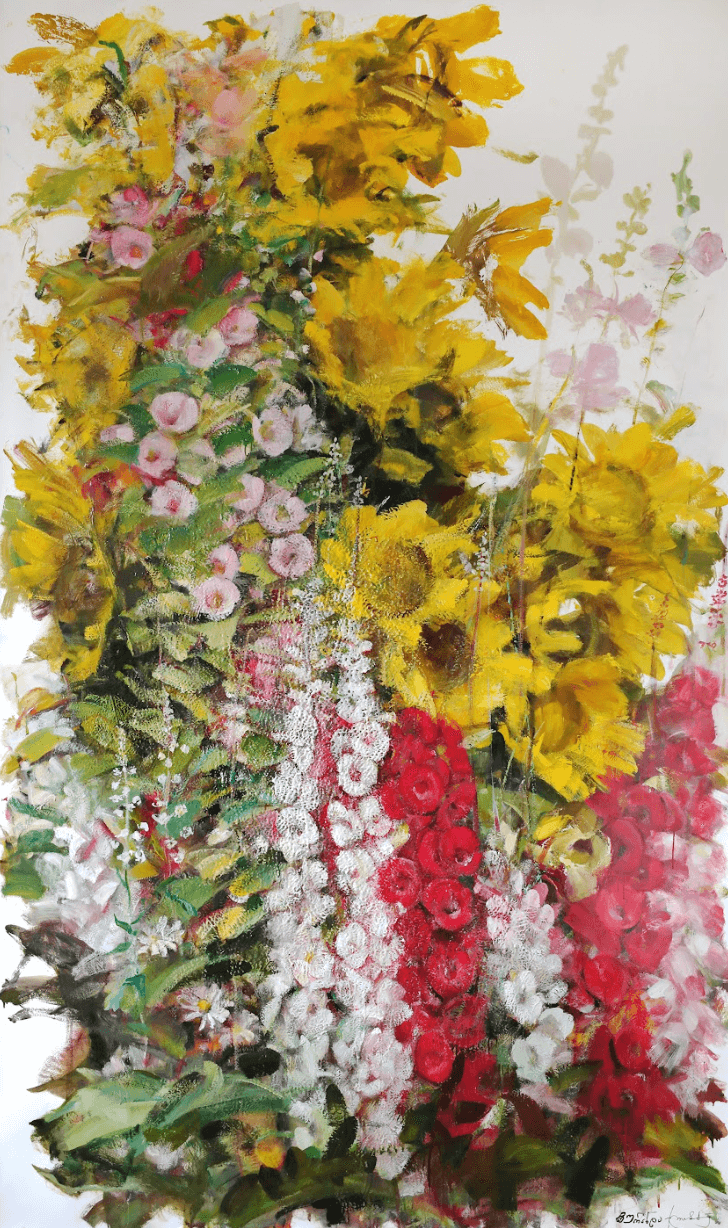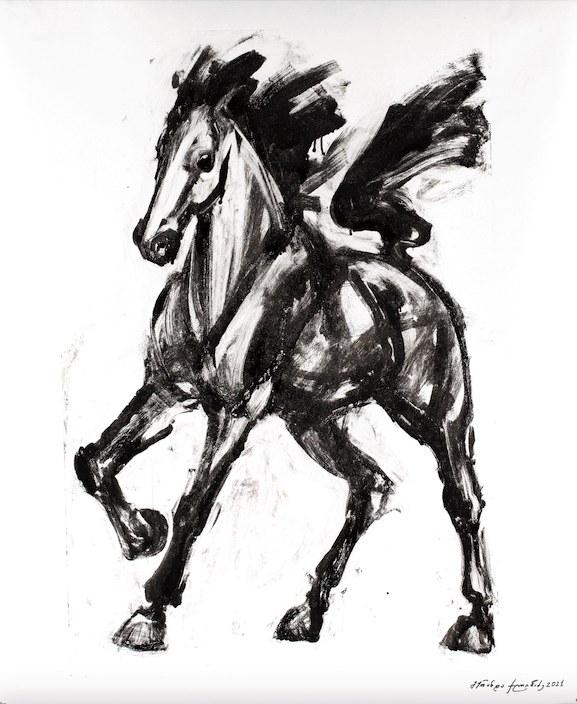
Feel free to add tags, names, dates or anything you are looking for


Guranda Klibadze is an outstanding representative of modern Georgian fine art, whose works convey powerful emotions and dramatic passions. She amazes us with her uncompromising directness in narration, laconic and incredibly tense compositional solution, and a masterful grasp of emotive language. Guranda Klibadze's paintings drag us into the imaginary world with magnetic force, and leave an indelible mark on the viewers’ consciousness.

Guranda Klibadze. The blue horse. Typographical paint on paper. 150x98. This work is part of ATINATI Private Collection
While still a student at the Tbilisi Academy of Arts, Klibadze boldly moved away from the idyllic and artificially complicated national-ethnographic subjects of Georgian painting of the previous period, particularly in her diploma work ‘History of Prostitution’. This is where the main characteristic essence of her work began to emerge. In her works, the artist always asks difficult questions, and answers them herself with maximum sincerity. The dialogical structure of Guranda Klibadze's art mainly consists of paired images. ‘Eve and Adam’ and ‘Paradise Apple Tree;’ ‘Sancho Panza the Governor’ and ‘Don Quixote;’ ‘Medea and Jason’ and ‘King Aeeta;’ ‘The Battle’ and ‘The Passion of the Kings.’
Guranda Klibadze. Medea and Jason. Typographical paint on cardboard. 100x100

Guranda Klibadze. Aeetes. Typographical paint on paper. 150x150. 2014

Guranda Klibadze. Medea and Jason. Typographical paint on paper. 150x110. 2013
Guranda Klibadze, who was still quite young at the time of her graduation from the Tbilisi Jacob Nikoladze Art School, chose to illustrate Marquis de Sade's works, which had recently been translated into Georgian. Her mixed media series depicts the setting, types, and style of costumed scenes of the Marquis de Sade's literary characters; ink and pen works drawn with great delicacy and conveying a wonderful Rococo-style atmosphere. Klibadze's early works demonstrate high levels of professional expertise, with nothing to indicate the timidity of a novice artist. She prefers works of an erotic character, yet she does not depict eroticism in her paintings. Eroticism, like love, is part of a woman's intimate life, and this theme naturally appears in the artist's work.
Who is a woman? What is her place in the world? What is her purpose in society? These are the questions that the artist asks and answers herself. Pregnant Eve is proud and persistent; full of optimism, she is looking to the future. An exhausted naked woman sitting in the courtyard of the Ishtar temple and waiting for an admirer is soul-stirring. ‘Babylonian Women’; Medea, who is drunk with love and trusts the passionate and powerful Jason, is incredibly convincing.

Guranda Klibadze. Eve and Adam. Typographical paint on paper. 150x149,5. 2013
Guranda Klibadze. Babylonian women. Typographical paint on paper. 105x88. 1999
That is why Guranda Klibadze is regarded as one of the founders of the erotic theme among Georgian female painters. Indeed, her work is distinguished by its ability to provide access to an individual's psychic essence. The naked and fatigued Don Quixote is unique, an image that is truly innovative in the diverse gallery of images of Don Quixote. Here, there is a sense of the danger of selflessness and chivalric innocence fading, from the perspective of a modern artist. It can be contrasted with her paired artwork ‘Sancho Panza the Governor’, which shows a servant, dressed in rags, wearing a luxurious feathered hat and riding a donkey proudly, feeling like a Spanish grandee - a voracious visage of momentary glory.
Guranda Klibadze. Don Quixote. Typographical paint on paper. 150x78. 2011
Guranda Klibadze. Sancho Panza as governor. Typographical paint on paper. 150x150. 2011
The artist's most recent large-format panels depict scenes of profound human spiritual loneliness, and the struggle for self-preservation; conveying a sense of extreme tragedy and an almost inevitable doom. It is rather difficult to comprehend the content of these panels. ‘The Battle’ scene is particularly remarkable, depicting a person entangled in a dizzying web of choices and opportunities. The solution is not observed even in ‘The Passions of the Kings.’ In this piece, the executioner and the king seem to be in a constant state of mutual substitution. All these pictures are black and white, with monumental figures portrayed on a flat, white surface using a free, strong brushstroke. Sculptural style is the defining feature of Guranda Klibadze's black-and-white paintings. They function within the conditional space assigned to them, while simultaneously inviting the viewer to interact with them directly.

Guranda Klibadze. The Passions of War. Typographical paint on paper. 150x413,5. 2022
The stark contrast of black and white emphasizes strong emotions. Simultaneously, the artist creates pictorial images where colors cascade over the viewer with unrestrained emotional intensity.
The theme of Klibadze's painting is flowers, set in a magical, intertwined, and hazy environment. The flowers and grass are depicted on a grand scale compared to humans, making us feel as though we have entered a world of giants, mirroring the characters in her paintings. The colorful palette of flowers, their tonal richness, and the amazing feeling of light and atmosphere, imbue these gardens with a magical, fabulous quality, transferring us to an entirely different reality.

Guranda Klibadze. Flowers. Typographical paint on paper. 165x150. 2022

Guranda Klibadze. Garden. Typographical paint on paper. 250x150. 2024

Guranda Klibadze. Sunflowers. Typographical paint on paper. 250x150. 2024

Guranda Klibadze. Sunflowers. Typographical paint on paper. 150x259. 2024

Guranda Klibadze. Flowers. Typographical paint on paper. 235x150. 2023
An essential component of Klibadze's artistic world is animalistic images. Certain animals, including dogs, donkeys, cranes, sparrows and horses, may speak on their own, or be incorporated into figurative compositions. Because of their untamed, free spirit, horses can represent both the flow of time and human freedom in general. They exhibit the artist's ravenous energy in a different way, which is consistently a sign of novelty and hope. A vital emotion for human existence is optimism, a love of life.

Guranda Klibadze. Horse. Typographical paint on paper. 150x125. This work is part of ATINATI Private Collection

Guranda Klibadze. Cranes. Typographical paint on paper. 250x150. 2024

Guranda Klibadze. Horse. Typographical paint on paper. 50x299,5. This work is part of ATINATI Private Collection
.jpg)
Guranda Klibadze. “The Return of Jesus from Egypt.” Typographical paint on paper. 150x170. This work is part of ATINATI Private Collection
She conveys her gratitude to the creator of the universe through her painting, which includes multiple images, among them ‘Adoration of the Shepherds’, ‘St. Joseph’, various cycles of the Annunciations, and, most notably, ‘The Return of Jesus from Egypt’. This image, like ‘Don Quixote,’ presents a thoroughly authoritative viewpoint on the subject. Young Jesus returns to us with the help of his devoted parents. His outstretched arms represent adoration and happiness in a cross shape. He arrives to offer humanity fresh ideas and the prospect of eternal life. Guranda Klibadze believes that the power of love for eternal life is to be found in Jesus' return, a belief which never leaves her, and which opens the door to fresh, imaginative quests.